
- Grand Piano Model
- Brand
- Features
- 3d Effect (2)
- Adjustable (3)
- Adjustable, Durable (197)
- Auto Pedal (3)
- Black Mackintosh (3)
- Black Vinyl (3)
- Brick Separator (2)
- Brown Mackintosh (4)
- Brown Vinyl (4)
- Built-in Effects (8)
- Built-in Speaker (5)
- Easy To Install (31)
- Features: (13)
- Finished (3)
- Lightweight (21)
- Matching Bench (5)
- New (4)
- Oval Speakers X 2 (8)
- Pitch Wheel (3)
- Rebuilt (2)
- ... (2650)
- For Instrument
- Instrument
- Model
- Grand (82)
- Grand Piano (33)
- Kawai Grand (16)
- Mason & Hamlin (22)
- Micropianord (12)
- Model A (25)
- Model B (18)
- Model D (12)
- Model M (18)
- Model O (28)
- Model S (11)
- Model: (13)
- Pianos (20)
- Quilted (38)
- St-6 (12)
- Steinway Grand Piano (59)
- Steinway Model B (13)
- Steinway Model L (17)
- Steinway Model M (15)
- Upright (160)
- ... (2350)
- Type
- Baby Grand Piano (104)
- Chair (13)
- Concert Grand Piano (9)
- Digital Piano (21)
- Door Hinge Half (7)
- Figurine (7)
- Grand Model Kit (85)
- Grand Piano (1005)
- Grand Piano Cover (86)
- Grand Piano Covers (66)
- Hinge Half (13)
- Music Ornaments (39)
- Parts (10)
- Piano (5)
- Piano Accordion (16)
- Piano Cover (27)
- Regular Type (6)
- Strobe Tuner (11)
- Upright Model Kit (149)
- Virtual Instrument (6)
- ... (1289)
Mason & Hamlin Model 50
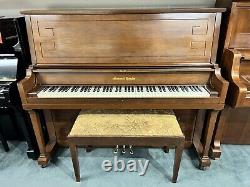
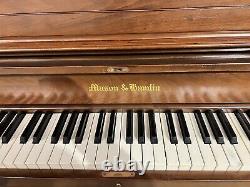
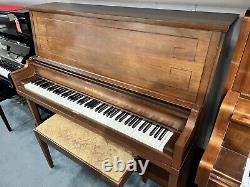
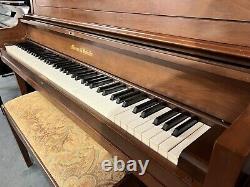
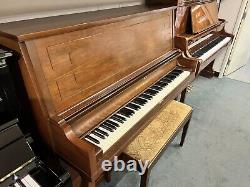
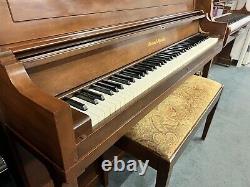
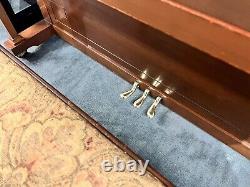

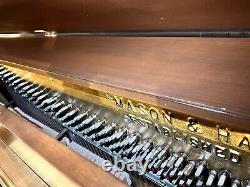


Here we have a reconditioned Mason & Hamlin Model 50 Upright Piano. Make: Mason & Hamlin Model: Model 50 Finish: (SW) Satin Walnut Status: Used/Reconditioned. Mason & Hamlin was founded in Boston, Massachusetts in 1854 by Henry Mason, son of Lowell Mason, the American hymn composer and musical educator, and Emmons Hamlin, a mechanic and inventor who had worked for melodeon makers Prince & Co. They originally manufactured only melodeons, but in 1855 introduced the organ-harmonium or flat-topped cabinet organ. This design placed the bellows vertically and underneath the reeds and served as the model for the suction operated American-style reed organ.
Mason & Hamlin supplied organs to several prominent composers, notably Franz Liszt, whose name the company applied to their patented selective sustain mechanism for organs comparable to the sostenuto in pianos. Mason & Hamlin began manufacturing pianos in 1883. Initially they built only upright pianos featuring a patented method of tuning and maintaining string tension which they marketed as the screw stringer and intended as an improvement over the traditional system with tuning pins.
In 1895, the piano department was completely reorganized by Richard W. Gertz, an independent piano designer from Germany who had created new scales for them earlier that year.
Gertz was elected secretary of the company in 1903, and president in 1906, and had patented the company's Tension Resonator, a device fastened to the perimeter of the wooden structure of pianos meant to prevent their sounding boards from flattening. This was first included in their grands in 1900. The most illustrious concert artists of the day aligned themselves with piano manufacturers; Sergei Rachmaninoff used a Mason & Hamlin to make his 1924 recording of his Second Piano Concerto. Composer Maurice Ravel said of Mason & Hamlin pianos, While preserving all the qualities of the percussion instrument, the Mason & Hamlin pianoforte also serves magnificently the composer's concept by its extensive range in dynamics, as well as quality of tone.American positioned Mason & Hamlin as the "artist's brand" among the firm's premier lines, which also included Chickering and Sons ("family use") and Wm. American's sales began to decline in 1928 and collapsed after the stock market crash in late 1929.
In 1932, American itself merged with Aeolian, consolidating the control of more than 20 brands of pianos in the Aeolian-American Company. Mason & Hamlin, which had been at the former Hallet, Davis & Company piano factory in Neponset, Massachusetts, was moved to a separate plant at the Aeolian-American complex in East Rochester, New York.
The company began sponsoring the Mason and Hamlin Prize piano competition. Piano manufacturing ceased in the United States in 1942 under authority of the War Production Board due to World War II, and Mason & Hamlin production shifted to military gliders. The company changed hands several times during the post-war era, becoming part of the Sohmer piano company in 1985. Over the decades, the designs of the pianos were altered to the extent that they had little in common with the "classic" Mason & Hamlin pianos of the pre-Depression era [citation needed]. He named the new enterprise the Mason & Hamlin Companies. Greer's goal was to resurrect the Mason & Hamlin pianos of the pre-Depression era by returning to the original specifications-including Gertz's scale designs-and use of materials. A few changes were made, including the use of Renner action parts and slightly longer keys. From 1990 to 1994, about 600 pianos were manufactured, mostly Model A and BB grands, along with a few Model 50 uprights. Kirk Burgett, after taking control of Mason & Hamlin, had engineers digitally reconstruct blueprints of the company's high-quality pianos in the early 1900s, acquired decades-old, specialized tools, and trained the first employees for two years, in order to produce pianos with a high level of craftsmanship like the offerings from the late 19th century and early 20th century. Mason & Hamlin pianos are still manufactured in Haverhill and distributed throughout the U. Mason & Hamlin is a member of NAMM, the International Music Products Association and Piano Manufacturers Association International. Each Mason & Hamlin piano includes a Tension Resonator, which is a system of steel rods under moderate tension, anchored to the wooden structure on the opposite side of the sounding board from the strings and iron frame. In grand pianos these rods fan out from one or two central hubs and are attached at intervals around the rim and to the belly rail; the model 50 upright has a rod stretched between the case sides. This adds strength and rigidity to the rim by locking the rim into its permanent shape and which in turn preserves the "crown" of the soundboard.(Mason & Hamlin Model 50) as advertised. Located at our Burbank location. This item is in the category "Musical Instruments & Gear\Pianos, Keyboards & Organs\Pianos\Grand & Baby Grand Pianos". The seller is "hollywood_piano" and is located in this country: US. This item can be shipped to United States.
- Number of Keys: 88
- Brand: Mason & Hamlin
- Number of Pedals: 3
- Type: Upright Piano
- Size: 60 in
- Color: Brown
- Model: 50
- Instrument: Grand Piano
- Height: 48 in
- Country/Region of Manufacture: America
- Finish: Satin Walnut
- Width: 58 in

